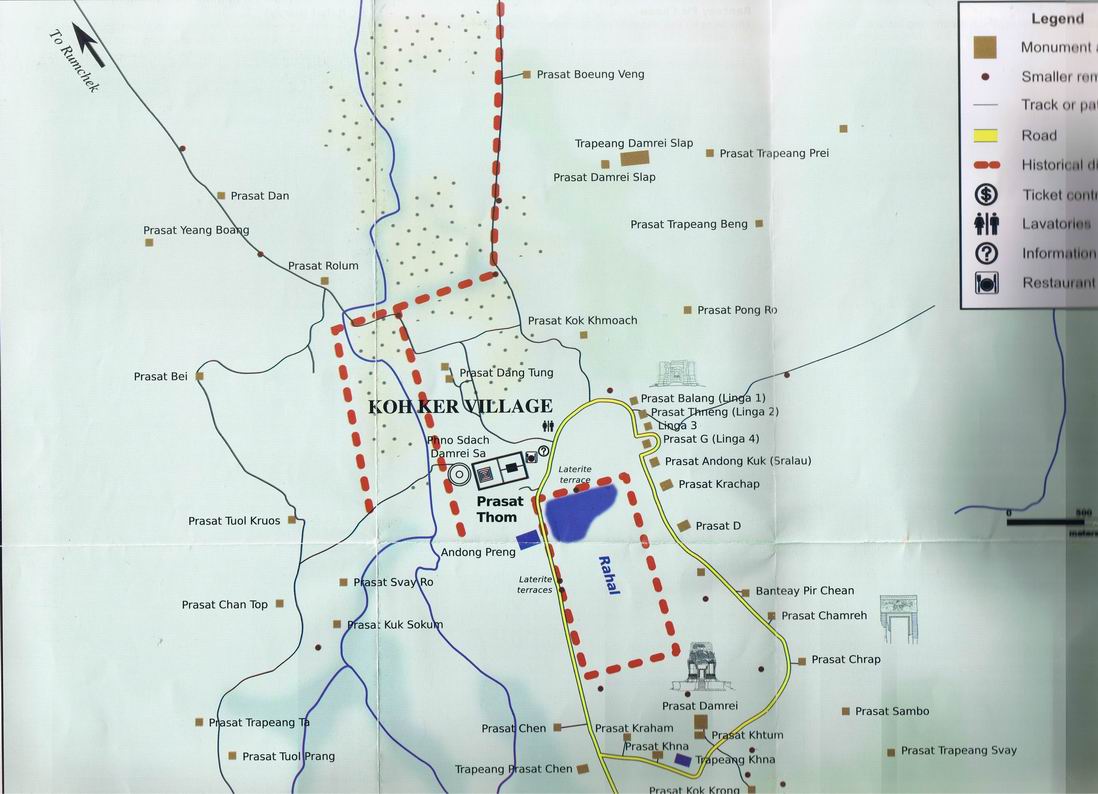Not only the location of the capital was changed, the classical building style of a state temple representing Mount Meru was not continued. In stead, the existing style of Koh Ker was extended, finally resulting in what was to become the highest Khmer temple: Prasat Thom. Just like a few other important temples, the already existing Wat Phu (near Champasak in present day Laos ) or the future Preah Vihaer (on a top of the Damrek mountains bordering Thailand and Cambodia), the state temple of king Jayavarman IV was built in a line.
Nowadays, these temples are the main attraction of the Koh Ker region and very well accessible with few, but adequate facilities. However, the Koh Ker region has many more worthwhile sites, to name a few: Prasat Andong Kuk, Prasat Pir Chean, Prasat Damrei, the remains of the baray of Rahal, Prasat Balang, the scarce remains of historical dykes. The map pictured here shows the location of these sites. In practice, there will always be a driver with you from what ever transport you chose to come here, and please do stick with him and do listen to him, or ask him for an experienced local, for this one good reason: the area is largely demined, but not completely. The Khmer Rouge has been very active in this region before they retreated to the border with Thailand in 1979 and placed numerous landmines.
Koh Ker is about 100 km north east of Angkor. I went there in August 2011, that is in the rainy season, but with two preceding days without rain, the road was dry and reasonably clear of potholes. I spoke to a Japanse tourist who came there solo from Siem Reap with his Cambodian driver by motorbike (quite extraordinary for a Japanese tourist, he admitted), but especially in the rainy season it is safer and faster to take a private car, or taxi. The road from Siem Reap has a solid surface until the junction near the temple of Beng Mealea, where tickets for both temple complexes are sold. From there on, a sand road with a fairly solid surface leads to some unused tollgates and eventually to the Koh Ker area. Near Prasat Thom, there are tourist stalls for souvenirs and food and little further on there are toilets. |
|

The drivers let me alone with the monuments, and with just 2 or 3 other visitors over this wide area, alone really means alone. However, when I tried to climb the temple using the wooden structure, the guide who inspected my ticket at entry showed up, prohibiting me from climbing. He said the wooden ladder was not safe, and the stone structure was not to be set foot on. What a pity: no climbing means no view from the top. Walking around the base of the pyramid proved to be very worthwhile instead.
During my visit, the atmosphere in Koh Ker was of an almost sacred kind. The quietness, the heavy, humid air, the bricks of the temple, the long grass, the flies, the shadows varying from pale with the sun behind a cloud or sharp, when it appeared again - it is like magic.The feeling of respect that it gave me must have been similar to that of a commoner while the temple was still in service.
Prasat Thom is large and impressive; the only other temple I visited, Prasat Damrei, is small, ruined and hidden in the jungle, but no less atmosperic. |
